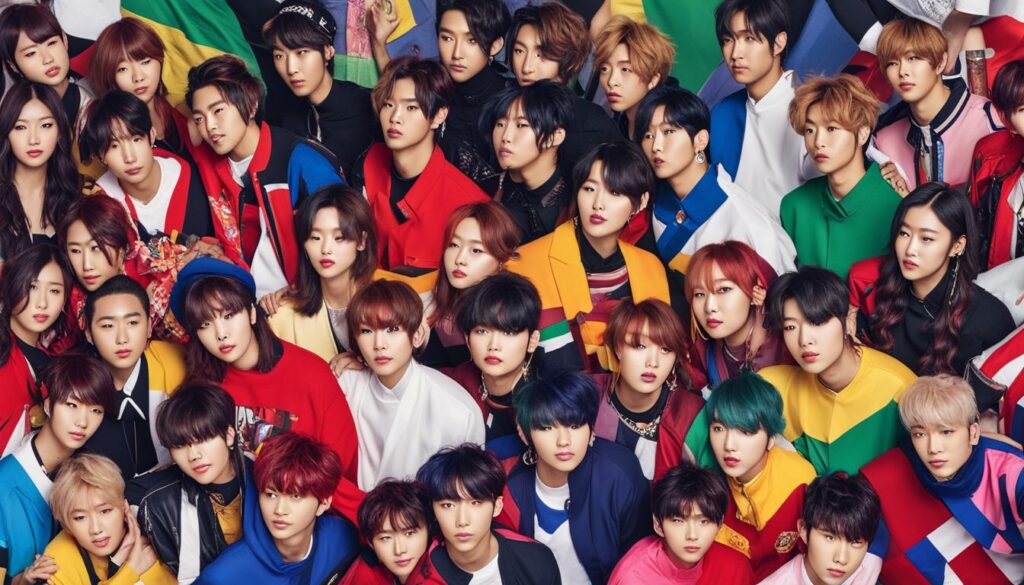If you’ve been online in the past few years, you’ve likely encountered the K-wave craze, the global cultural phenomenon that has captivated audiences worldwide. From K-pop, K-dramas, K-cinema, to K-fashion and beauty trends, the K-wave is everywhere. But what is the K-wave, and why is it so popular? In this article, we’ll unpack the K-wave’s rise to fame, exploring its impact, significance, and cultural influence. So, get ready to embark on a journey of discovery and unravel the mystery behind the K-wave phenomenon.
What is the K-wave?
The K-wave is the global spread and influence of South Korean culture. It encompasses a range of cultural offerings, including K-pop music, K-dramas television shows, K-cinema movies, fashion, beauty trends, and more. The K-wave has become a global cultural phenomenon due to its captivating and innovative offerings that have attracted audiences worldwide.
K-pop, one of the key elements of the K-wave, has gained a massive international following and successfully crossed over into the mainstream music industry. K-dramas, television shows known for their compelling storytelling and visually stunning production values, have gained a loyal fan base worldwide. Internationally acclaimed K-cinema films, such as “Parasite” and “Train to Busan,” have captured the hearts of audiences globally, showcasing the unique storytelling and artistic prowess of South Korean filmmakers. Fashion and beauty trends, influenced by South Korean design and skincare routines, have also gained popularity around the world.
The K-wave phenomenon has expanded beyond entertainment, fostering cultural exchange and showcasing South Korea’s soft power on a global stage. It has broken language barriers and boosted economic sectors such as tourism, entertainment, fashion, and beauty, making a significant impact on South Korea’s economy.
The Rise of K-pop
If you haven’t heard of K-pop yet, it’s time to start paying attention. K-pop is one of the most significant elements of the K-wave, and it’s been on the rise for a few years now. K-pop groups, such as BTS and Blackpink, have achieved unparalleled global popularity, successfully crossing over from the Korean market to the international music scene. The popularity of K-pop cannot be overstated, and it’s becoming a massive cultural phenomenon.
K-pop’s success can be attributed to its unique fusion of music, dance, and fashion. K-pop artists typically have extensive training and often have to undergo intense auditions to be able to debut. This dedication and hard work are reflected in their exceptional performances, which showcase complex choreography and stunning visuals paired with catchy tunes that appeal to a wide audience.
Impact of K-pop on the K-wave trend
The rise of K-pop has had a significant impact on the K-wave’s trend. The music genre has become synonymous with South Korea, and it has helped cement South Korea’s cultural influence across the globe. K-pop has enabled South Korea to showcase its unique style and identity while reaching a massive international audience. As a result, K-pop has become a critical driver of the K-wave trend and has led to an increased interest in K-wave elements beyond music.
Significance of K-pop’s mainstream success
K-pop’s success in crossing over into the mainstream music industry is noteworthy and worth analyzing. By breaking into the American and European music markets, K-pop has defied the norm and challenged the boundaries of cultural representation in Western media. The success of K-pop signals a change in the global music industry and a shift towards greater cultural diversity and inclusivity, opening up opportunities for artists from non-English speaking countries.
“The saturation of K-pop into the music industry has blurred cultural lines and created a beautiful mesh of different cultures in one place.” – Anonymous Fan
As one of the K-wave’s most significant contributors, K-pop’s global impact cannot be overstated. Its rise in popularity demonstrates the power and reach of South Korean culture and has introduced the world to a new style of music and performance. With the continued growth of K-pop and the K-wave trend, we can only expect greater things to come from South Korea’s vibrant entertainment industry.
The Allure of K-dramas
K-dramas have become a significant element of the K-wave trend, thanks to their impact on audiences worldwide. These television shows are known for their compelling storytelling, taking viewers on emotional rollercoasters with characters that are relatable and multidimensional. The visually stunning production values are another hallmark of K-dramas, showcasing South Korea’s expertise in cinematography, art direction, and costume design.
The popularity of K-dramas can be attributed to their ability to connect with audiences on a personal level, transcending cultural and linguistic barriers. The diverse range of genres, including romance, comedy, action, and historical dramas, offers something for every viewer. The themes often delve into societal issues, such as mental health, family dynamics, and social justice, adding an extra layer of complexity to the narratives.
The significance of K-dramas in the K-wave cannot be underestimated. They have played a critical role in introducing South Korean culture to a global audience and have spurred an interest in learning the Korean language. K-drama tourism has also become a thriving industry, with fans from around the world traveling to South Korea to visit filming locations and immerse themselves in the world of K-dramas.
“K-dramas have introduced me to a whole new world of storytelling and culture. The emotional depth of the characters and the stunning visuals never fail to captivate me.” – A K-drama fan
The Influence of K-cinema
K-cinema, or South Korean cinema, has played an essential role in the K-wave trend. The success of internationally acclaimed movies, such as “Parasite” and “Train to Busan,” has showcased the unique storytelling and artistic prowess of South Korean filmmakers.
The impact of K-cinema is evident in the global recognition of South Korean filmmakers, who have been consistently creating high-quality films that present an innovative approach to storytelling. The success of “Parasite,” which won several international awards, including four Oscars, has undoubtedly contributed to the growing global appreciation of K-cinema.
K-cinema’s significance lies in its ability to connect with audiences on a human level, telling stories that resonate and evoke emotion. South Korean filmmakers’ ability to present thought-provoking, visually stunning films has caught the attention of audiences worldwide, making them eagerly anticipate each new release.
South Korean cinema has had a significant impact on the K-wave phenomenon as a whole, further adding to the country’s cultural prestige. K-cinema represents a fresh and exciting take on cinematic storytelling, all while staying true to South Korean culture’s core values and beliefs.
K-fashion and Beauty Trends
When it comes to the K-wave trend, fashion, and beauty are equally important. K-fashion has been making waves with its innovative designs and unique streetwear. Korean streetwear has exploded in recent years, with Seoul being recognized as one of the fashion capitals of the world. From oversized jackets to layered clothing, K-fashion is all about being bold and unique. This trend has influenced global fashion trends, and many fashion enthusiasts look up to Korean street style icons for inspiration.
Similarly, K-beauty products and skincare routines have become increasingly popular in recent years. The K-beauty industry is known for its innovative products and focus on achieving healthy, radiant skin. From hydrating toners to sheet masks, K-beauty products prioritize natural ingredients and gentle formulas. It’s no wonder that the K-beauty trend has become a global phenomenon, with many people around the world incorporating Korean skincare routines into their daily lives.
The K-wave’s impact on fashion and beauty cannot be underestimated. K-fashion has brought fresh designs and styles to the fashion industry, and K-beauty has revolutionized skincare routines around the world. As the K-wave continues to grow, it is exciting to see how Korean fashion and beauty trends will evolve and influence the global market.
The Global Fandom Culture
The K-wave has given rise to an intense global fandom culture, with fans from different countries and cultures coming together to celebrate their shared appreciation for K-pop, K-dramas, and other South Korean cultural offerings. The fandom has grown exponentially in recent years, with fans creating dedicated online communities, fan clubs, and fan events.
This sense of community has been further amplified through social media platforms like Twitter, Instagram, and TikTok, where fans share fan art, memes, dance covers, and other creative content. The K-wave fandom has also led to the creation of fan-generated content such as music videos, webcomics and fan fiction, further contributing to the phenomenon’s immense popularity.
One significant impact of this fandom culture is its ability to boost the K-wave’s reach and influence, helping to propel South Korean cultural content to new heights of popularity. K-pop idols, actors, and artists have become household names worldwide, thanks to the unwavering support of their fans.
“I was really impressed by the passion and dedication of K-pop fans around the world, they’ve taken the fandom to another level.” – Celeste Ng
In addition to increasing the popularity of K-wave elements, the fandom has also helped to strengthen the cultural exchange that kickstarted the K-wave trend in the first place. Fans’ interest in South Korean language, cuisine, and tourism has led to a greater understanding of the country’s heritage and customs.
Top 5 Most Popular K-Pop Artists on YouTube as of 2021
| Rank | Artist | Subscribers (in millions) | Most-Watched Music Video (in billions of views) |
|---|---|---|---|
| 1 | BTS | 47.1 | Dynamite (1.1) |
| 2 | Blackpink | 59.5 | Ddu-Du Ddu-Du (1.6) |
| 3 | Twice | 17.7 | Fancy (0.6) |
| 4 | Red Velvet | 7.3 | Psycho (0.3) |
| 5 | EXO | 23.7 | Love Shot (0.4) |
As evident from the table, K-pop artists have a massive following on YouTube, with billions of views for their music videos. This underscores the immense popularity of K-wave elements among global audiences, further highlighting the extent of the K-wave’s impact on the world of entertainment and beyond.
Cultural Exchange and Soft Power
The far-reaching impact of the K-wave has gone beyond entertainment and has contributed to fostering cultural exchange and showcasing South Korea’s soft power on a global scale. The popularity of K-wave elements has led to an increased interest in South Korean language, culture, tourism, and even culinary offerings.
One significant example of the K-wave’s cultural influence can be observed in the increasing number of individuals around the world learning the Korean language. The online availability of Korean language tutorials, K-pop songs, and K-dramas has made it easy for the global audience to familiarize themselves with the language, leading to a renewed interest in Korean culture and increasing appreciation for South Korean cultural offerings.
The K-wave has also been instrumental in promoting South Korea’s tourism industry. The widespread popularity of K-dramas has led to an increase in tourists visiting South Korea to experience the locations and culture depicted in these shows. According to the Korean Tourism Organization, the number of Vietnamese tourists visiting South Korea increased by 337% after the airing of the popular K-drama “Descendants of the Sun”.
Furthermore, the K-wave has contributed to showcasing South Korea’s soft power, which is the ability to influence others through non-military means, such as culture, values, and diplomatic power. The international recognition of South Korean culture has helped promote and strengthen the country’s image and diplomatic relations with other nations. Through its cultural offerings, South Korea has successfully projected a positive image of itself onto the global stage, generating respect and admiration from audiences around the world.
Breaking Barriers and Language Impact
The K-wave has seen a significant impact on global audiences due to its universal appeal, breaking barriers of language and culture. While the primary language of K-pop music and K-dramas is Korean, diverse audiences have been attracted to the unique music, compelling storytelling, and captivating performances. The K-wave has transcended beyond typical language barriers, proving that music and entertainment have the power to unite people from various backgrounds and cultures.
One of the reasons for the K-wave’s success is the focus on relatable storytelling, exploring universal themes of love, heartbreak, and personal growth that resonate with people all over the world. The music videos and performances often convey strong emotions through electrifying choreography, stunning visuals, and impressive vocals.
The K-wave has not only exposed people to Korean language and culture but also inspired many to learn the language. The demand for Korean language classes has increased globally, providing economic benefits and opportunities for educational and cultural exchange.
The K-wave’s ability to break down language barriers has allowed for the creation of a global community of fans, who passionately support their favorite K-pop idols and actors. The K-wave has brought together people from all over the world, showcasing the universality of music and entertainment.
The Impact
The K-wave’s success in transcending language barriers has resulted in a massive global impact, contributing to the popularity and influence of K-pop, K-dramas, and other K-wave elements. This has led to an increased interest in Korean language, culture, and travel. The K-wave has had a significant impact on the global entertainment industry, highlighting the importance of inclusivity and diversity in media.
Social Media and Digital Platforms
The K-wave has been able to reach audiences all over the world thanks to the rise of social media and digital platforms. YouTube, for example, has been instrumental in promoting K-pop music videos and allowing fans to interact with their favorite artists. As a result, K-pop has become a global phenomenon and a significant trend in the music industry.
Streaming services have also played a crucial role in the spread of the K-wave. Through platforms like Netflix and Viki, fans have access to a plethora of K-dramas, showcasing the unique storytelling and production values of South Korean television shows.
Moreover, social media platforms such as Twitter and Instagram have given fans the opportunity to connect with each other and share their enthusiasm about the K-wave. Dedicated fan accounts and hashtags have made it easy for fans to stay engaged with their favorite K-pop idols and celebrities.
The Impact of Social Media on the K-wave Trend
The impact of social media on the K-wave trend cannot be overstated. Apart from promoting and disseminating K-wave content, social media also allows for real-time engagement, giving fans the power to influence and shape the K-wave trend. The use of social media hashtags, for example, has allowed fans to communicate their preferences and help chart the direction of the K-wave.
“Social media is playing a huge part in shaping the K-pop phenomenon. Fans are able to have a direct line to their idols and participate in shaping the industry through their choices and preferences.” – Jane Kim, K-pop Fan
As the K-wave continues to evolve, social media and digital platforms will undoubtedly play a vital role in its growth and sustainability.
Economic and Tourism Boost
The K-wave has had a significant impact on South Korea’s economy, thanks to the increased international interest in K-wave elements. One of the key areas that have seen a boost is the tourism industry, with a growing number of travelers visiting South Korea to experience K-wave culture first-hand. According to the Korean Tourism Organization, the number of visitors to South Korea has increased steadily in recent years, with an estimated 17 million tourists visiting the country in 2019 alone.
The popularity of K-wave elements, such as K-pop, K-dramas, and K-cinema, has also contributed to the growth of the entertainment industry in South Korea. K-pop, in particular, has become a significant export for the country, with K-pop artists performing in sold-out arenas worldwide and contributing to the country’s economy through merchandise sales and album releases.
The fashion and beauty industries in South Korea have also benefited from the K-wave phenomenon, with Korean fashion and beauty products enjoying increased popularity globally. Brands such as Innisfree, Etude House, and Laneige have opened stores worldwide, while Korean fashion designers have showcased their collections in major fashion weeks across the world.
The K-wave’s impact on South Korea’s economy is undeniable, with the country’s cultural exports and increasing global influence drawing visitors and boosting industries such as tourism, entertainment, fashion, and beauty. As the K-wave continues to gain momentum, its impact on South Korea’s economy is expected to grow and further contribute to the country’s development.
K-wave Conclusion
Now that you have delved into the phenomenon of the K-wave, it is clear that its popularity is not just a passing trend. The K-wave has become a cultural force to be reckoned with, captivating audiences around the world with its unique offerings.
The K-wave includes elements of K-pop, K-dramas, K-cinema, and K-fashion, each with its own significant impact on the global cultural landscape. The K-wave’s power lies in its ability to foster cultural exchange and showcase South Korea’s soft power, breaking language barriers and appealing to audiences of diverse backgrounds and cultures.
The K-wave has also brought significant economic benefits to South Korea, with an increased interest in industries such as tourism, entertainment, fashion, and beauty. This is a testament to the influence and impact of the K-wave on a global scale.
As the K-wave continues to gain momentum, it will undoubtedly have a lasting impression on the global cultural landscape. The K-wave is not merely a passing trend but a global cultural phenomenon that will continue to shape the entertainment, fashion, and beauty industries, fostering cultural exchange and showcasing South Korea’s soft power.

















































